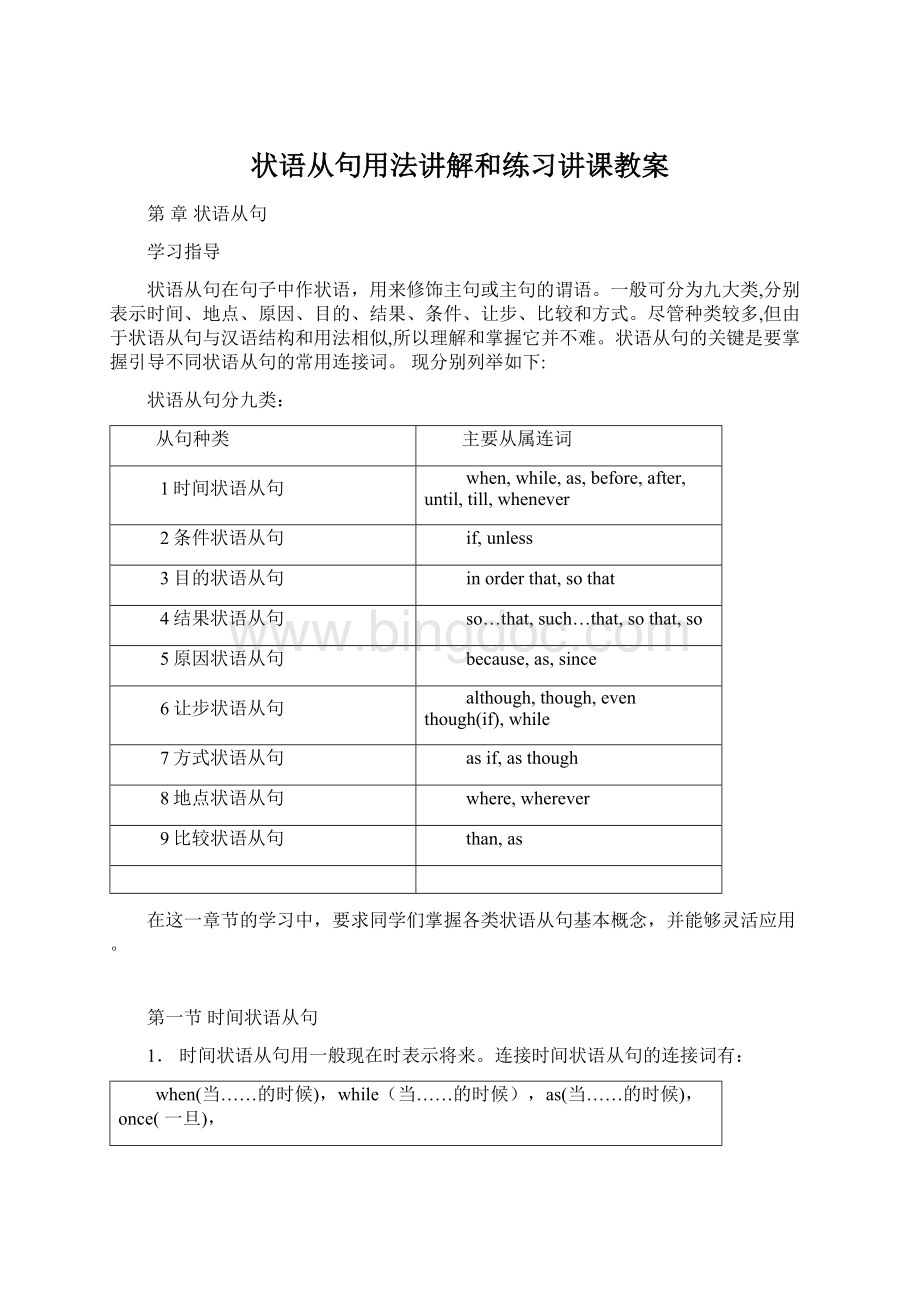状语从句用法讲解和练习讲课教案.docx
《状语从句用法讲解和练习讲课教案.docx》由会员分享,可在线阅读,更多相关《状语从句用法讲解和练习讲课教案.docx(14页珍藏版)》请在冰点文库上搜索。

状语从句用法讲解和练习讲课教案
第章状语从句
学习指导
状语从句在句子中作状语,用来修饰主句或主句的谓语。
一般可分为九大类,分别表示时间、地点、原因、目的、结果、条件、让步、比较和方式。
尽管种类较多,但由于状语从句与汉语结构和用法相似,所以理解和掌握它并不难。
状语从句的关键是要掌握引导不同状语从句的常用连接词。
现分别列举如下:
状语从句分九类:
从句种类
主要从属连词
1时间状语从句
when,while,as,before,after,until,till,whenever
2条件状语从句
if,unless
3目的状语从句
inorderthat,sothat
4结果状语从句
so…that,such…that,sothat,so
5原因状语从句
because,as,since
6让步状语从句
although,though,eventhough(if),while
7方式状语从句
asif,asthough
8地点状语从句
where,wherever
9比较状语从句
than,as
在这一章节的学习中,要求同学们掌握各类状语从句基本概念,并能够灵活应用。
第一节时间状语从句
1.时间状语从句用一般现在时表示将来。
连接时间状语从句的连接词有:
when(当……的时候),while(当……的时候),as(当……的时候),once(一旦),
till(until)(一直到……,直到……才),bythetime(到……时),assoonas(一……就)themoment(一……就).since(自从……).before(在……前).after(在……后)
2.when,while,as均可表示“当……的时候”。
when强调“特定时间”,表示主句谓语动词的动作与从句谓语动词的动作是同时发生的,或从句的动作发生在主句的动作之前;while表示的时间是一段,而不是一点,as多用在口语中,强调“同一时间”或“一前一后”,有时还有“随着”的含义。
I'llgoonwiththeworkwhen/comebacktomorrow.我明天回来后会继续做我的工作。
Whenspringcame,hefeltlikeatrip.春天来了,他想去旅游。
Asspringwarmsthegoodearth,allflowersbegintobloom.(as有“随着”的含义)
as,when,while都表示主、从句的动作或状态同时发生,但三者也有区别。
as和when引导的从句既可表示一点时间,也可表示一段时间,从句中的谓语动词既可以是持续性动词,也可以为短暂性动词,经常可以互换使用;while引导的从句通常表示一段时间,从句中宜用持续性动词作谓语。
当从句中的谓语动词为持续性动词时,这三者可以通用(前面例句中已有体现),再如:
MotherwasworriedbecauselittleAlicewasill,especiallyas/when/whilefatherwasawayinFrance.妈妈担心,因为小艾丽思病了,特别是当父亲远在法国的时候。
如果从句和主句要表示一个人的两个动作交替进行或同时完成时,则多用as,可译为“一边......,一边......”。
例如:
Helookedbehindfromtotimeashewent.他一边走,一边不时地往后看。
Astimegoeson,it’sgettingwarmerandwarmer..随着时间的推移,天气变得越来越暖了。
Ithoughtofitjustasyouopenedyourmouth.你一张嘴我就知道你要说什么。
(若表示两个短促动作几乎同时发生时,用as的场合多于when.)
当主从句之间表示转折或对比关系时,多用while,不用as或when。
如:
ShethoughtIwastalkingaboutherdaughter,whileinfact,Iwastalkingaboutmydaughter.她以为我在谈论她女儿,而事实上,我在谈论我的女儿。
如果表示从句的动作在主句的动作“之前”或“之后”发生时,多用when(=after),不用as或while。
此外,when还含有“atthatmoment”的意思(=andthen),引起的句子不能放在句首,也不能用as,while来替换。
例如:
Hewasabouttoleavewhenthetelephonerang.他正要离开,忽然电话铃响了。
WewerewatchingTVwhensuddenlythelightswentout.我们正在看电视,突然灯灭了。
Theyhadjustarrivedhomewhenitbegantorain.他们刚到家,天就开始下雨了。
3.till/until,表示“一直到……”,主从句都用肯定式;表示“直到……才”,主句否定,从句肯定。
Heworkeduntilitwasdark.他一直工作到天黑。
Hedidnotgetuptillhismothercamein.一直到母亲进来他才起床。
4.once“一旦”,bythetime“到……时”。
Onceyouseeher,youwillfindwhatIsaidistrue.一旦你见到她就会发现我说的是对的。
bythetime+现在时,主句用将来完成时。
Bythetimehearrives,wewillalreadyhavelefthere.等他到达时,我们将已离开这儿了。
bythetime+一般过去时,主句用过去完成时。
Bythetimehearrived,wehadalreadylefthere.他到达的时候我们早已离开这儿了。
5.assoonas,themoment表示从句动作一发生,主句动作随即发生,通常译为“一……就”。
AssoonasIfinishthework,I'llgotoseeyou.我一完成工作就会来看你。
Shecametothescenethemomentsheheardthenews.她一听到消息就来到现场。
6.since“自从”,before“在……前”,after“在……后”,Itwasnotlongbefore意为“不久”。
since引导从句用非延续性动词或“过去时间点”或“过去时间段+ago”,主句用完成时态。
Sincehegraduated,hehasworkedinthiscity.他毕业后一直在这个城市工作。
Ihaven'tseenhimsincelastyear/threeyearsago.去年以来/3年来,我没见过他。
选出最佳答案
1)hewaslisteningtothemusic,Johnfellasleep.
A.AfterB.BeforeC.WhileD.Assoonas-
2)Howdidyoutrytogettoschoolontimeyoumissedtheschoolbus.
A.whenB.howC.whyD.that
3)Hewasridingtoschoolhewashitbyacarthismorning.
AwhileB.whenC.asD.so
4)Lucyknewnothingaboutithersistertoldher.
A.becauseB.untilC.ifD.since
5)Thepolicemanaskedthechildcrossthestreetthetrafficlightsturnedgreen.
A.not;whenB.don't;beforeC.notto;untilD.notto;since
6)Thebookwassointerestingthathehadreaditforthreehoursherealizedit.
A.whenB.afterC.untilD.before
7)wehadseenalltheanimals,wewenthome.
A.ThenB.AfterC.ThoughD.While
8)Shehasmademanyfriendsshecametoourschool.
A.beforeB.afterC.sinceD.until
9)—Howlonghastheweatherbeenlikethis?
A.UntillastnightB.Eversincelastnight
C.TwodaysagoD.Twodayslater
10)MyunclewenttoAustralialastyear.Wehaven'tseenhim.
A.sincealmostayearB.fromalmostayearon
C.afteralmostayearD.sincealmostayearago
11)Hewassotiredthathefellasleephewenttobed.
A.asifB.eventhoughC.eversinceD.assoonas
12)Iknewnothingabouttheaccidentmyfriendtoldmeyesterday.
A.becauseB.sinceC.untilD.after
13)Ididn'tmanagetodoityouhadexplainedhow.
A.untilB.sinceC.whileD.after
【Keys】1)C2)A3)B4)B5)A6)D7)B8)C9)B10)D11)D12)C13)A
第二节条件状语从句
1.条件状语从句用一般现在时表示将来。
引导条件状语从句的连词有:
if如果;unless除非,如果不;onconditionthat条件是;aslongas只要
2.表示正面的条件用if“如果”。
Ifyoudon'tlookafteryoungtrees,theywilldieveryquickly.
Ifthemuseumchargesforentry,alotofpeoplewon'tbeabletovisitit.
3.表示否定的条件用unless(=if...not)“除非,如果不”。
IshallnotgotothecinemaunlessIfinishmyhomeworkbeforeeight.
说明:
if…not常可以用unless替代。
Ifyoudon’tstudyhard,youwillfailintheexam.
Youwillfailintheexamunlessyoustudyhard.
4.表示使某事成为现实必要的条件用onconditionthat“条件是”,aslongas‘‘只要”。
Youmaygoswimmingonconditionthatyoudon'tswimtoofarawayfromtheriverbank.
Aslongasyoudon'tstudyhard,youwillfailintheexam.
5.祈使结构表条件。
前半部分的祈使结构相当于if条件句,可用动词或名词开头;后半部分的简单句常用一般将来时,有时也用一般现在时。
此句型与条件状语从句形成同义结构。
1)祈使句(,)+and/then+简单句=>if从句(否定式)+主句
Givemesomewheretostand,andIwillmovetheearth.(如果)给我一个支点,我便能掀动地球。
=Ifyougivemesomewheretostand,Iwillmovetheearth.
Onemoreword,andI'llturnyouout.你再多说一句,我就把你赶出去。
=Ifyouspeakonemoreword,Iwillturnyouout.
Useyourhead,thenyou'llfindaway.动动脑子你就能找到办法。
=Ifyouuseyourhead,you'llfindaway.
2)祈使句(,)+or+简单句=>if从句(否定式)+主语
Workevenharder,oryouwillneverpasstheexam.如果不加倍努力,你就永远无法通过考试。
=Ifyoudon'tworkharder,youwillneverpasstheexam.
Stoptellinglies,oryouwillbepunished.如果你继续说谎,就会受到惩罚。
=Ifyoudon'tstoptellinglies,youwillbepunished.
选择最佳答案填空
1)—Wouldyouliketogototheparkwithme,Susan?
—I'dliketo,youdon'twanttogoalone.
A.untilB.beforeC.ifD.after
2)Tomorrowwe'llgotothecityparkitissunny.
A.assoonasB.whenC.ifD.as
3)Allofuswillbehappyyoucancomewithus.
A.whileB.ifC.butD.or
4)NobodycanlearnEnglishwellyouworkhardonit.
A.ifB.unlessC.whenD.but
5)Thesportsmeetwillcontinueitrainsthisafternoon.
A.ifB.sinceC.assoonasD.unless
【Keys】1)C2)C3)B4)B5)D
第三节原因状语从句和地点状语从句
1.原因状语从句
引导原因状语从句的连词有:
because,for,since,as,nowthat
1)because意为“因为”,表示直接的原因或理由,着重点在从句,用于回答why,语气最强。
Heisabsenttodaybecauseheisill.他今天缺席,因为他病了。
Ididn'tgooutbecauseIwasbusywithhomework.我没有出去,因为我忙于家庭作业。
有时,可用becauseof后接名词或代词表示原因,此时becauseof=for(介词)。
Wewon'tbeabletocomebecauseoftheweather.由于天气的原因,我们来不了。
Shewaslookingallthebetterforherstayinhospital.她因为待在医院,显得好多了。
2)for意为“因为”,引导的从句并不说明主句行为发生的直接原因,只提供补充说明,且不可位于主句前。
for前往往用逗号或分号与主句分开,引起的从句对主句加以解释。
Ididn'tgotoseehim,foraheavysnowwasfalling.我没有去看他,因为在下大雪。
Thedayswereshort,foritwasnowDecember.白天短了,因为现在已经是十二月了。
Wemustbeginplanningnow,forthefuturemaybringunexpectedchanges.
我们必须现在就开始筹划,因为将来可能会发生意想不到的变化。
有时,for引起的从句并不表示原因,而是表示一种推断或解释,而because则不能。
Someoneinthehousemustbeill,foradoctorhasjustcomeout.房子里一定有人病了,因为有个医生刚刚出来。
3)since意为“既然”、“由于”,一般表示对方已知的、无需加以说明的既成事实的理由(如果从句表示的原因不是确定的事实,就不能用since,通常用because)。
Sinceyouaregoing,Iwillgotoo.既然你要走,我也走了。
Sinceyouareill,I'llgoalone.由于你病了,我就一个人走了。
4)as意为“由于”,表示十分明显的原因,一般说明因果关系,着重点在主句,语气较弱。
Asitissnowing,weshallnotgotothepark.由于正在下雪,我们就不去公园了。
Hehadtoapologize,asheknewhehadmadeamistake.他必须道歉,因为他知道他错了。
由as表示的原因语势最弱,常用于口语。
5)nowthat意为“既然”,有时可将that省去,含义与since接近。
区别在于:
since表示原先已存在的情况,而nowthat表示现在才发生的情况。
Nowthatithasstoppedraining,let'sstartatonce.既然现在雨停了,咱们马上开始吧!
Nowthatyouhavecome,youmayaswellstay.既然来了,你最好还是待在这儿。
2.地点状语从句
引导地点状语从句的连词有:
where,wherever,anywhere,everywhere
Putitwhereyoucanseeit.把它放在你看得见的地方。
I'llfindhim,whereverheis.不管他在哪里我都要找到他。
Youshouldputthebookwhereitwas.你应该把书放在原来的地方。
Whereveryougo,youshoulddoyourworkwell.不论你到哪里都要把工作做好。
选择最佳答案
1)IhopetogotoFrancesomedaytherearemanyfamousmuseumsthere.
A.thoughB.unlessC.becauseD.where
2)—Wouldyouliketogototheconcertwithme?
—I'dloveto,Ican't.Ihavealotofhomeworktodo.
A.and;BecauseB.but;BecauseC.so;AndD.and;so
3)Jimhasbeeninthefactoryfortwoyears____________heleftschool.
A.whenB.sinceC.assoonasD.whether
4)Jackwasverytiredheplayedtennisallafternoon.
A.ifB.assoonasC.becauseD.before
5)You'dbettercomebackearlieritisgettingcolder.
A.asB.andC.butD.or
6)Janeworearaincoatitwasraining.
A.soB.butC.howeverD.because
7)TheItalianboywasregardedasaherohegavehislifeforhiscountry.
A.accordingtoB.becauseofC.onaccountofD.because
【Keys】
1)C2)B3)B4)C5)A6)D7)D
第四节让步状语从句
1.引导让步状语从句的连词有:
although,while,eventhough,evenif,whether...(ornot),用nomatter十wh-/how引导
2.although/though“虽然”。
AlthoughIdidn’tknowanybodyattheparty,Ihadaverygoodtime.虽然晚会上的客人我一个也不认识,但我玩得很愉快。
[注意]“although…but”是个典型的错误,因为but是并列连词,不能与从属连词although连用。
但是,although可与yet,still连用,因为yet,still是副词,它可使前后关系更明确。
3.while意为“然而”。
1)while用于对照,说明两种情况相反,意为“然而,但是”。
Tomisveryoutgoing,whileJaneisshyandquiet.汤姆性格外向,而简却腼腆安静。
WhileIwasreading,hewasplaying.我在读书,而他在玩。
2)while意为“虽然,尽管”,同although,此时从句和主句的主语往往为同一人或物。
Whileshelikedcats。
sheneverletthemcomeintoherroom.虽然她喜欢猫,但她从不让猫进她的房间。
4.evenif“即使”(if后陈述的是假设);eventhough“尽管”(though后陈述的是事实)。
I'mgoingtoap